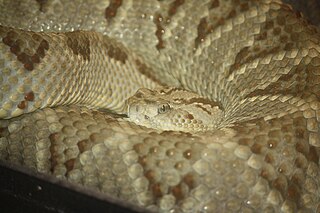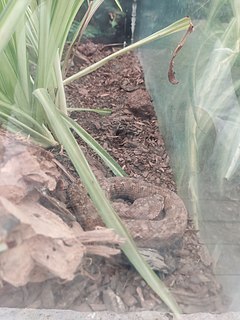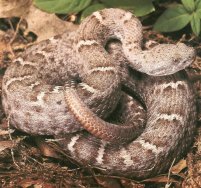
Crotalus basiliscus is a species of venomous pit viper in the family Viperidae. The species is endemic to western Mexico. The specific name, basiliscus, is derived from the Greek word for king, βασιλισκος, and alludes to this snake's large size and potent venom. No subspecies are currently recognized.

Crotalus willardi is a venomous pit viper species found in the southwestern United States and Mexico. This snake is found mainly in the "sky island" region. The IUCN reports this snake's conservation status as being of Least Concern. It is the official state reptile of Arizona.

Crotalus mitchellii is a venomous pit viper species in the family Viperidae. The species is endemic to the Southwestern United States and adjacent northern Mexico. The species was named in honor of Silas Weir Mitchell (1829–1914), an American medical doctor who also studied rattlesnake venoms. Five subspecies are currently recognized, including the nominate subspecies described here.

Crotalus ravus, commonly known as the Mexican pigmy rattlesnake or Mexican pygmy rattlesnake, is a venomous pit viper species, found only in Mexico. Three subspecies are currently recognized.

Crotalus viridis nuntius is a venomous pit viper subspecies native primarily to the desert plateau of the northeastern portion of the American state of Arizona, but also ranges into northwestern New Mexico. Named for the Native American Hopi tribe, which inhabits the region, its range overlaps that of the nominate subspecies and some interbreeding is believed to occur. The taxonomy of the C. viridis group is a matter of debate, many considering the various subspecies to be nothing more than locality variations.

Crotalus simus is a venomous pit viper species found in Mexico and Central America. The specific epithet is Latin for "flat-nosed", likely because its head is blunt compared with lanceheads (Bothrops). Three subspecies are recognized, including the nominate subspecies described here.

Crotalus oreganus, commonly known as the (northern) Pacific rattlesnake, is a venomous pit viper species found in western North America from the Baja California Peninsula to the southern interior of British Columbia.

Crotalus intermedius is a venomous pit viper species found in central and southern Mexico. Three subspecies are currently recognized, including the nominate subspecies described here.
Crotalus intermedius gloydi is a subspecies of venomous pitviper in the family Viperidae. The subspecies is endemic to Mexico in the states of Oaxaca and Puebla.

Crotalus pricei is a species of venomous snake, a pit viper in the family Viperidae. The species is endemic to the southwestern United States and northern Mexico. Two subspecies are recognized.

The Mexican lance-headed rattlesnake or lance-headed rattlesnake is a venomous pit viper species found in central Mexico. No subspecies is currently recognized.

Crotalus pusillus is a venomous pit viper species found in west-central Mexico. No subspecies is currently recognized.

Crotalus stejnegeri, commonly known as the Sinaloan long-tailed rattlesnake or just long-tailed rattlesnake, is a venomous pit viper species in the family Viperidae. The species is native to western Mexico. There are no recognized subspecies.

Crotalus transversus is a venomous pit viper species found in central Mexico, known from less than 20 specimens. No subspecies are currently recognized.

Crotalus triseriatus is a venomous pit viper species found in Mexico. Two subspecies are currently recognized, including the nominate subspecies described here.

Crotalus cerastes cercobombus is a venomous pitviper subspecies found in an area that covers much of the eastern part of the Sonoran Desert in the southwestern United States and northwestern Mexico. The subspecific epithet means buzzertail.

Crotalus willardi obscurus is a venomous pitviper subspecies found in northwestern Mexico and the Southwestern United States.
Crotalus totonacus is a venomous pit viper species found in northeastern Mexico. No subspecies are currently recognized.
Crotalus lorenzoensis is a species of pitviper, a venomous snake in the subfamily Crotalinae of the family Viperidae. The species is endemic to San Lorenzo Sur Island, Mexico.
Crotalus ruber lucasensis is a venomous pitviper subspecies found in Mexico in the Cape region of lower Baja California.















